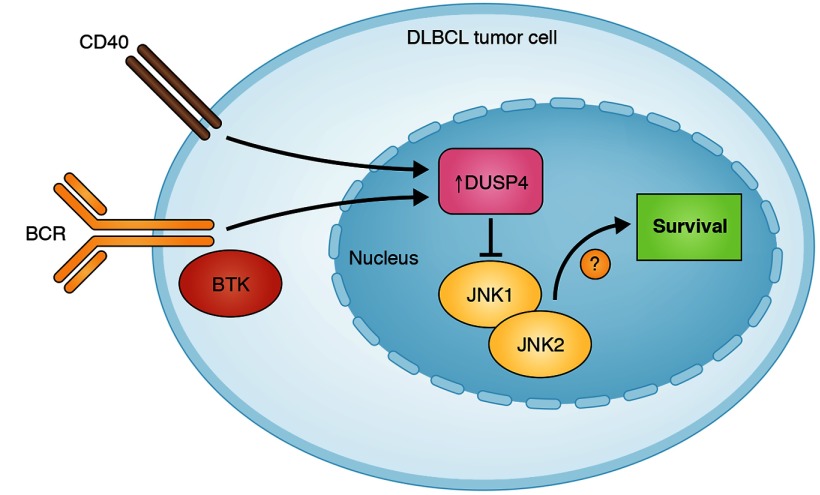
Insight from Robert Rickert
Diffuse large B cell lymphoma (DLBCL) is a heterogeneous B cell malignancy that can be stratified into three molecular subtypes using gene expression profiling: activated B cell–like DLBCL (ABC-DLBCL), germinal center B cell–like (GCB-DLBCL), or mediastinal B cell–like. In this issue, Schmid et al. report that aberrant methylation results in loss of DUSP4 expression in most (75%) DLBCL cases, suggesting that DUSP4 functions as a novel tumor suppressor.
The dual-specificity phosphatases (DUSPs) are a family of 25 phosphatases that can dephosphorylate both tyrosine and serine/threonine residues. A primary substrate of the DUSPs are the MAP kinases, which are inhibited by dephosphorylation of a critical motif in the kinase domain.
B cell activation (e.g., via BCR and CD40 engagement) induces the expression of DUSP4, which negatively regulates JNK1/2 by dephosphorylation, resulting in apoptosis. Inhibition of BTK and JNK1/2 act synergistically to promote apoptosis of lymphoma cells.
In this study, the authors first screened for potential DLBCL tumor suppressors that could be epigenetically silenced by DNA methylation. They used genome-wide DNA methylation analyses coupled with gene expression profiling after pharmacological DNA demethylation and identified DUSP4 as one of eight genes impairing cell survival when ectopically expressed in DLBCL lines. Of the MAP kinase targets of DUSP4, they focused on JNK1/2, because these kinases, unlike ERK1/2 and p38, were dephosphorylated in both ABC-DLBL and GCB-DLBCL. Further experiments showed that DUSP4 acts on nuclear JNK and that a small molecule JNK inhibitor targets the survival of selected DLBCL lines. This finding was validated in xenograft experiments, showing tumor reduction in animals receiving the JNK inhibitor. Interestingly, an additive effect was observed in ABC-DLBCL lines after coinhibition with a JNK inhibitor and ibrutinib, a Bruton’s tyrosine kinase (BTK) inhibitor, suggesting that JNK and BTK are synthetic lethal targets downstream of the BCR. Lastly, the absence of DUSP4 negatively correlated with patient survival in all subtypes of DLBCL.
This study illustrates the power of systematic epigenetic approaches in understanding dysregulated gene expression. DUSP4 is a relatively understudied target in cancer, whereas its substrates, the MAP kinases, are well-known regulators of cell fate. Additional investigations will be required to determine the relevance of the DUSP4/JNK1/2 axis in the stratification and treatment of other lymphoma types that also lack DUSP4. Moreover, the physiologic targets of JNK that promote lymphoma cell viability remain to be determined. The combinatorial effects of BTK and JNK inhibitors are intriguing and worthy of further study. In particular, it will be important to attribute the relative efficacy and synergy of these inhibitors to particular receptors/pathways versus prevalent off-target effects.
References
- Schmid, C.A., et al. 2015. J. Exp. Med. 10.1084/jem.20141957. [DOI] [Google Scholar]



